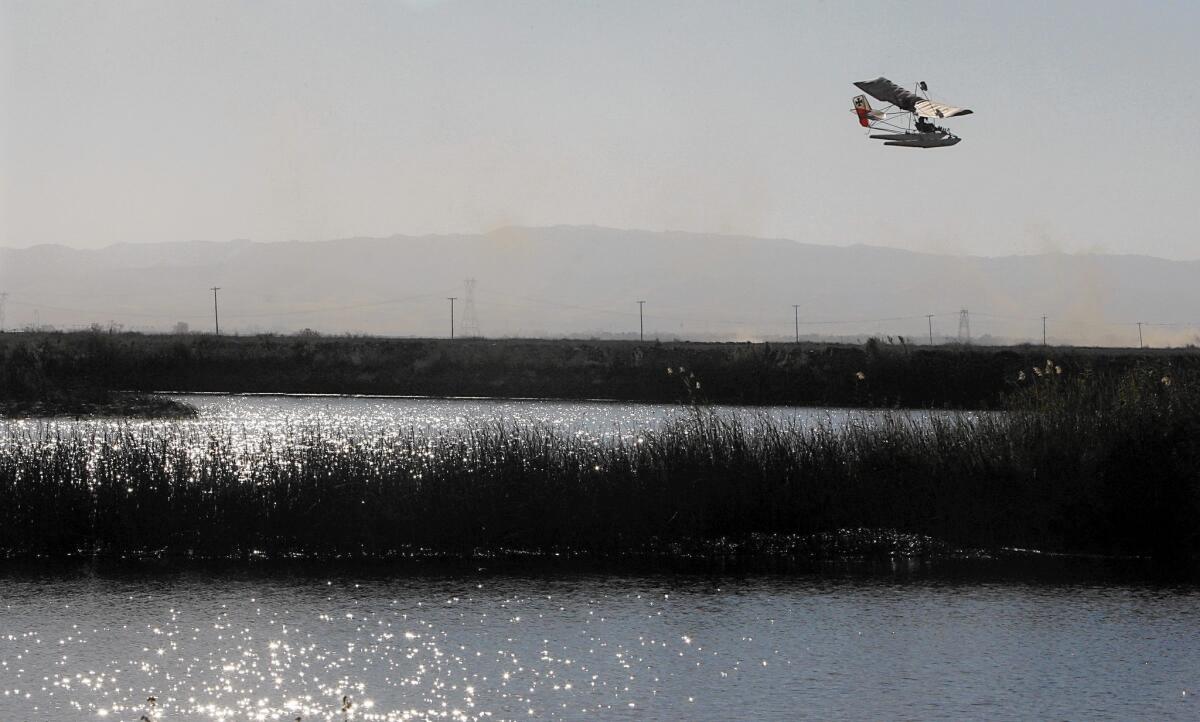MWD considers buying 4 delta islands to solve some water problems

Water deliveries from the Sacramento-San Joaquin River Delta have been progressively squeezed by environmental restrictions.
The Southland’s major water agency is considering buying 20,000 acres of farm islands in the hub of California’s water system, a move that could help stem cuts in deliveries from Northern California.
The land is owned by a private company, Delta Wetlands Properties, which for 30 years has tried to develop a water storage project on the islands. But officials of the Metropolitan Water District of Southern California said storage is only one of the ways they might use the acreage, much of which is now planted with corn.
In a staff presentation to an MWD committee Monday, Steve Arakawa, Metropolitan’s manager of Bay-Delta Initiatives, said the four islands could be managed to provide various water supply and environmental benefits, including carbon sequestration through marsh creation, fish and wildlife habitat and controlling salinity levels in the Sacramento-San Joaquin River Delta.
Water and Power is The Times’ guide to the drought. Sign up to get the free newsletter >>
Two of the islands are in the path of a proposed water tunnel system that MWD and other water agencies are backing. MWD ownership would eliminate the need for lengthy eminent domain proceedings. With the islands also would come water rights, some of which could potentially be used to boost southbound deliveries — or increase delta outflow to meet environmental standards.
The Real Property and Asset Management Committee voted Monday to recommend that the full board authorize staff to enter into an agreement to purchase or obtain an option on the islands. The board will take up the matter Tuesday.
Terms of the prospective deal were discussed in closed session and were not released. After the committee meeting, MWD general manager Jeffrey Kightlinger said Delta Wetlands had initiated talks two months ago. The company has made sales overtures in the past, he added, but until now there hasn’t been enough upside for MWD to justify the price.
That has changed as delta deliveries have been progressively squeezed by environmental restrictions accompanying the continuing crash of native fish populations. Constructing two massive water tunnels to carry Sacramento River water under the delta to southbound pumps is one project MWD and other urban and agricultural districts are pursuing to try to ease pumping limits.
The state is also trying to improve fish and wildlife habitat in the delta, a rural maze of levee-ringed farm islands and water channels that bears little resemblance to the sprawling complex of tule marsh that existed before settlers drained the land in the late 1800s.
Farming oxidizes the delta’s peat soils, causing parts of the delta to sink 15 feet to 20 feet below sea level. The islands MWD is eyeing are essentially bowls, which is why they could be used to store water.
Owned by a subsidiary of a Swiss insurance company, Zurich Insurance Group, Delta Wetlands proposed to capture flows in wet years, flood Bacon Island and Webb Tract and later transfer the water to partnering districts. The plan also called for converting Bouldin Island and Holland Tract to wildlife habitat.
Farmers on neighboring islands worried that the flooding would weaken levees and endanger their fields. They challenged the project in court and then agreed to a settlement that contained various safeguards.
Using peat islands as reservoirs also raises water quality issues. And any storage project would still have to go through a lengthy permitting process.
“We’ve always been skeptical of pure storage,” Kightlinger said. “We’re very intrigued with the potential environmental benefits.”
Although he indicated MWD hoped for other partners to join the island purchase, he said that was not certain. Nor did he know which projects the agency would pursue if it winds up a major delta landowner.
Twitter: @boxall
ALSO
California colleges step up efforts to help students in mental distress
Researchers detail what a Rockstar energy drink does to your body
Half of immigrants in state illegally could be eligible for Medi-Cal expansion, study finds







